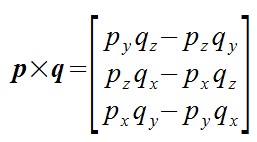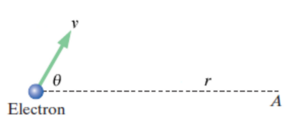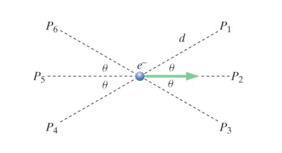Moving Point Charge
(Grace Townsend Spring 2017) Claimed by Blake Heard, Fall 2017
The Biot-Savart Law for the magnetic field of a moving charge can be quite complex in calculations. The method of calculations can be broken down further into simpler steps.
The Main Idea
A Mathematical Model
A moving point charge not only has an electric field due to its possession of a charge but also has a magnetic field due to its velocity. The magnetic field of a moving point charge can be found using a derivation of the Biot-Savart Law for magnetic fields.
where q is the scalar charge of the particle, v is the vector velocity of the moving particle, and r is the vector distance from the observation location to the position of the moving particle. The magnetic constant in the formula has the value of 1e-7 T(m/A). V × r is a cross product that can be computed by the formula:
A trigonometric equivalence of the above formula is (p)(q)sin(θ)
Which can be written in terms of v and r as: (v)(r)sin(θ) θ in this formula is the angle between the vectors v and r.
To determine the direction of the resulting vector from a cross product, we use the right hand rule where we align our right-hand fingers so that it can sweep from the vector v to the vector r. Where our thumb points as a result of this alignment is the direction of v × r. The final direction of the magnetic field will depend on the charge of our particle. If our particle is positively charged, the magnetic field will point in the same direction as v × r. If the particle is negatively charged, the magnetic field will point in the opposite direction as v × r.
The unit of our result will be in Tesla, the unit for a magnetic field.
Examples
Simple
At a particular instant, a proton at the origin has velocity < 4e4, -3e4, 0> m/s. Calculate the magnetic field at location < 0.03, 0.06, 0 > m, due to the moving proton.
Solution:
1. The first we need to do is find r hat. Given the vector <0.03, 0.06, 0>, we can calculate the normalized r hat vector to be < 0.447, 0.894, 0 >.
2. Once we have both the velocity and r hat vectors, we can take the cross product of these two as the equation  tells us to do.
Crossing these two, we get < 0, 0, 49200>
tells us to do.
Crossing these two, we get < 0, 0, 49200>
3. The magnetic field will be this cross product multiplied by the charge of the proton [math]\displaystyle{ 1.6*10^{-19} }[/math] and divided by the magnitude of r squared. Don't forget to also multiply this by [math]\displaystyle{ \mu_0 }[/math] or [math]\displaystyle{ 10^{-7} }[/math].
The final answer will be [math]\displaystyle{ \lt 0, 0, 1.75*10^{-19}\gt }[/math] T
Medium
The electron in the figure below is traveling with a speed of [math]\displaystyle{ v = 4*10^6 }[/math]m/s. What is the magnitude of the magnetic field at location A if r = [math]\displaystyle{ 7*10^{-10} }[/math]m and [math]\displaystyle{ \theta=57 }[/math] degrees
Solution:
1. First split up the velocity in to its x and y components by multiplying the given velocity by cos(57) and sin(57) for x and y respectively.
2. Find r hat and take the cross product of your new velocity vector with r hat.
3. Multiply this by the magnitude of the charge for an electron, as well as by [math]\displaystyle{ \mu_0 }[/math] and then divide this by [math]\displaystyle{ r^2 }[/math]
The final answer will be 0.11 T
Complex
An electron is moving horizontally to the right with speed [math]\displaystyle{ 6*10^6 }[/math] m/s. What is the magnetic field due to this moving electron at the indicated locations in the figure? Each location is d = 8 cm from the electron, and the angle θ = 33°. Give both magnitude and direction of the magnetic field at locations 1, 2 and 3.
Solution:
1. Find the r vector for each location, using [math]\displaystyle{ \theta }[/math] to calculate the x and y components
2. For each r vector, take the cross product v X r where the v is given.
3. Multiply each respective cross product by the magnitude of charge and [math]\displaystyle{ mu_0 }[/math].
4. In order to find the direction of the magnetic fields, use the Right Hand Rule. One way to do this is to point your thumb in the direction of the velocity, your pointer finger in the direction of r hat, and look which way your palm is facing in order to find the direction of the magnetic field.
At location P2 and P5 the magnetic field will be zero. P1 will be into the page, P3 will be out of the page, P4 will be out of the page, and P6 will be into the page, all with a magnitude of [math]\displaystyle{ 8.17*10^{-18} }[/math] T.
Important Applications
A single moving point charge represents the most simple situation of charges moving in space to produce a magnetic field. In reality, this situation rarely occurs, however understanding how a single moving point charge interacts to produce a field will allow you to understand how sets of moving charges produce a field in space as well.
We can use the magnetic field of a single moving charge formula to derive a more practical formula of a short current carrying wire:
Where dl is a vector pointing in the same direction as the conventional current This formula is more applicable to many real life situations where we can have macroscopic objects that can be used to calculate the magnetic field, such as the Magnetic Field of a Long Straight Wire or a Magnetic Field of a Loop.
We can apply the magnetic field formula to numerous situations by integration.
History
Oliver Heaviside first derived this relationship from Maxwell's Equations in 1888. The Biot-Savart Law was named after Jean-Baptiste Biot and Felix Savart who, in 1820, showed a needle deflection from a current carrying wire, thus relating electricity and magnetism.
See also
References
http://maxwell.ucdavis.edu/~electro/magnetic_field/pointcharge.html http://ruh.li/3DMathVectors.html



